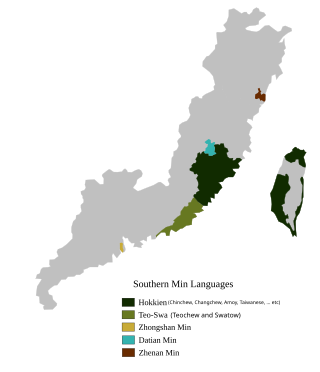This article includes a list of general references, but it lacks sufficient corresponding inline citations. (October 2012) |
| Teochew | |
|---|---|
| Chaozhou, Chaoshan, Teo-Swa | |
| 潮州話 / 潮汕話 / 潮語[1] | |
| Native to | Chaoshan |
| Region | Eastern Guangdong (Chaoshan), Thailand, Southern Vietnam and Cambodia, Indonesia (Jambi and West Kalimantan), Singapore |
| Ethnicity | Teochew people |
Native speakers | About 14 million in Chaoshan (2004)[2] more than 5 million overseas[citation needed] |
Early forms | |
| Dialects |
|
| Chinese characters Teochew Romanization Peng'im | |
| Language codes | |
| ISO 639-3 | None (mis) |
| Glottolog | chao1238 |
| Linguasphere | 79-AAA-ji |
 Teochew (Teo-Swa) within the Southern Min languages | |
| Teochew Min | |||||||||||||||||||||||||||||
|---|---|---|---|---|---|---|---|---|---|---|---|---|---|---|---|---|---|---|---|---|---|---|---|---|---|---|---|---|---|
| Traditional Chinese | 潮州話 | ||||||||||||||||||||||||||||
| Simplified Chinese | 潮州话 | ||||||||||||||||||||||||||||
| |||||||||||||||||||||||||||||
Teochew[ii], also known as Teo-Swa (or Chaoshan)[iii], is a Southern Min language spoken by the Teochew people in the Chaoshan region of eastern Guangdong and by their diaspora around the world. It is sometimes referred to as Chiuchow, its Cantonese rendering, due to English romanization by colonial officials and explorers. It is closely related to Hokkien, as it shares some cognates and phonology with Hokkien.
Teochew preserves many Old Chinese pronunciations and vocabulary that have been lost in some of the other modern varieties of Chinese. As such, Teochew is described as one of the most conservative Chinese languages.[6]
- ^ "學潮語,埋下愛的種子". Sin Chew. January 9, 2021.
- ^ Language atlas of China (2nd edition), City University of Hong Kong, 2012, ISBN 978-7-10-007054-6.
- ^ Mei, Tsu-lin (1970), "Tones and prosody in Middle Chinese and the origin of the rising tone", Harvard Journal of Asiatic Studies, 30: 86–110, doi:10.2307/2718766, JSTOR 2718766
- ^ Pulleyblank, Edwin G. (1984), Middle Chinese: A study in Historical Phonology, Vancouver: University of British Columbia Press, p. 3, ISBN 978-0-7748-0192-8
- ^ Hammarström, Harald; Forkel, Robert; Haspelmath, Martin; Bank, Sebastian (July 10, 2023). "Glottolog 4.8 - Min". Glottolog. Leipzig: Max Planck Institute for Evolutionary Anthropology. doi:10.5281/zenodo.7398962. Archived from the original on October 13, 2023. Retrieved October 13, 2023.
- ^ Yap, Foong Ha; Grunow-Hårsta, Karen; Wrona, Janick, eds. (2011). Nominalization in Asian Languages: Diachronic and typological perspectives. John Benjamins Publishing Company. p. 11. ISBN 978-9027206770.
Cite error: There are <ref group=lower-roman> tags or {{efn-lr}} templates on this page, but the references will not show without a {{reflist|group=lower-roman}} template or {{notelist-lr}} template (see the help page).